Doom metal captivates listeners with its heavy riffs, slow tempos, and dark themes. This genre creates an immersive atmosphere that evokes feelings of despair and introspection. Notable artists like Black Sabbath and Candlemass have shaped its sound, while sub-genres such as funeral doom and stoner doom introduce unique elements. Exploring these aspects enhances appreciation for the complexities of doom metal.
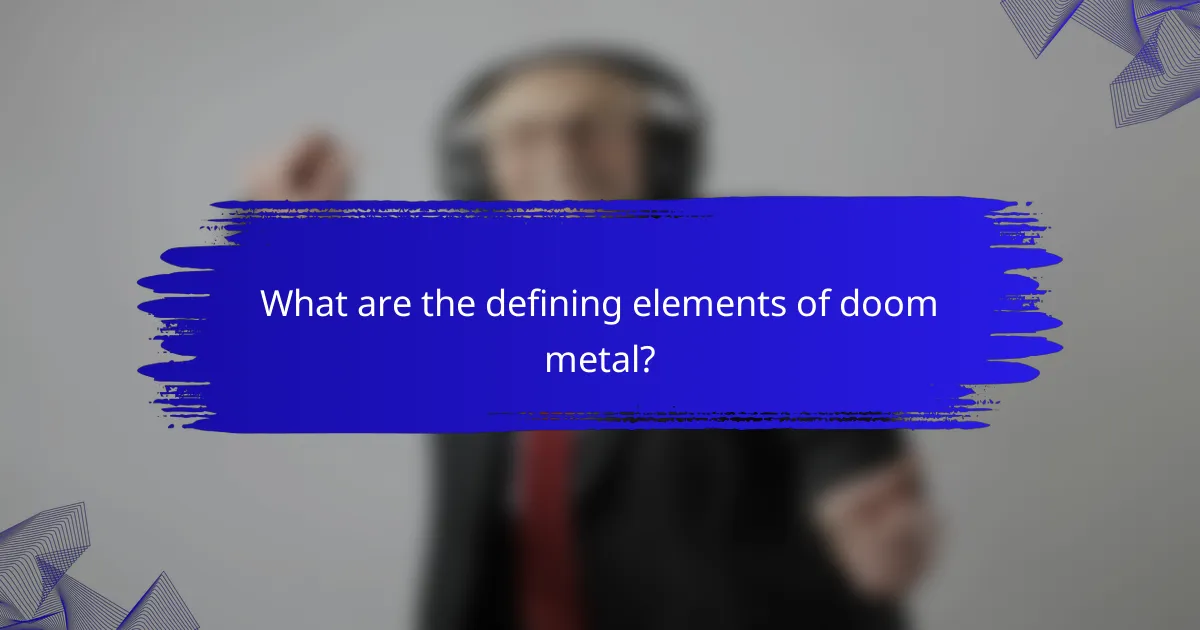
What are the defining elements of doom metal?
Doom metal is characterized by slow tempos, heavy guitar riffs, and dark, melancholic themes. The atmosphere often evokes feelings of despair and introspection. Notable artists include Black Sabbath, Candlemass, and Electric Wizard. Each contributes unique elements, such as Black Sabbath’s pioneering sound and Candlemass’ epic compositions. Doom metal’s root attributes include its heavy instrumentation and emotional depth, while unique elements can be found in the sub-genres like funeral doom and stoner doom.
How do musical characteristics shape the doom metal sound?
Doom metal sound is shaped by heavy guitar riffs, slow tempos, and dark lyrical themes. These characteristics create a dense atmosphere that evokes feelings of despair and melancholy. The genre often features distorted guitar tones and extended instrumental sections, enhancing its immersive quality. Notable artists like Black Sabbath and Candlemass exemplify these elements, influencing the genre’s evolution and defining its unique sound.
What lyrical themes are prevalent in doom metal?
Doom metal often explores themes of despair, existential dread, and the inevitability of death. These lyrical elements contribute to the genre’s heavy atmosphere. Notable artists like Black Sabbath and Candlemass exemplify these themes through dark imagery and slow tempos. The unique attribute of doom metal is its ability to evoke a sense of profound melancholy, setting it apart from other metal subgenres.
Which instruments are commonly used in doom metal bands?
Doom metal bands commonly use electric guitars, bass guitars, drums, and keyboards. These instruments create a heavy, slow sound characterized by thick guitar riffs and deep bass lines. Electric guitars often feature downtuning, enhancing the genre’s dark atmosphere. Drums provide a slow, pounding rhythm, while keyboards add atmospheric layers. Notable artists like Black Sabbath and Candlemass exemplify these instrumental elements.
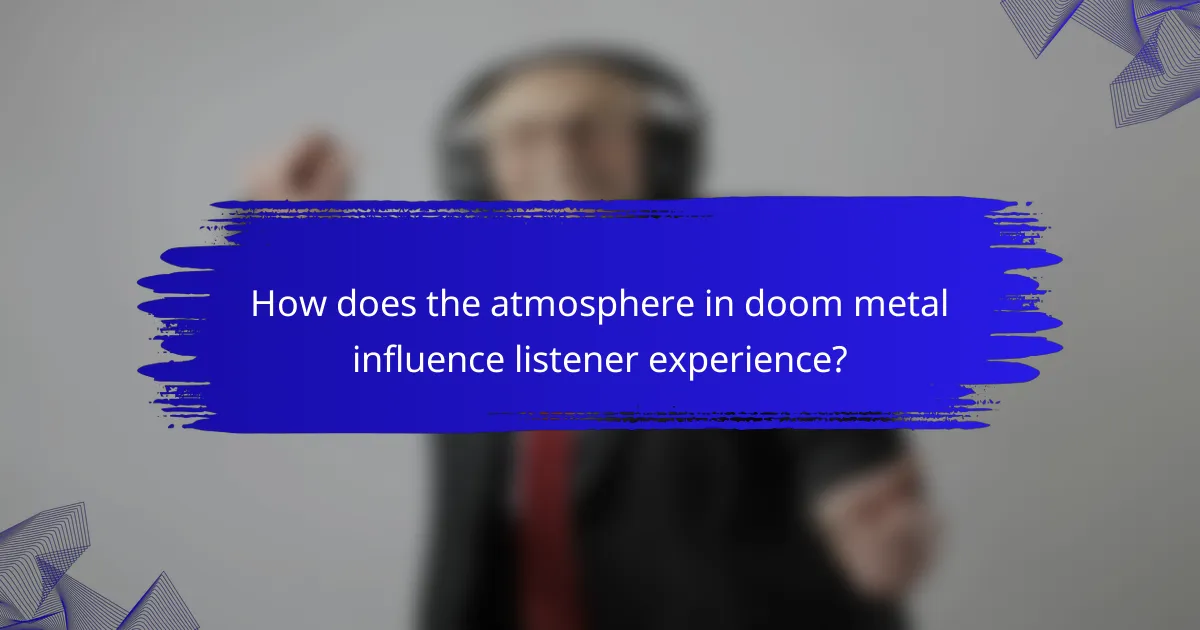
How does the atmosphere in doom metal influence listener experience?
The atmosphere in doom metal profoundly shapes listener experience by creating a heavy, immersive soundscape. This genre often features slow tempos, distorted guitars, and deep, melancholic vocals, evoking feelings of despair and introspection. The unique attributes of doom metal, such as its use of minor keys and atmospheric effects, enhance emotional depth. Notable artists like Black Sabbath and Candlemass exemplify these elements, drawing listeners into a dark, reflective journey. As a result, the atmosphere becomes a crucial aspect of how fans connect with the music.
What role does tempo play in creating doom metal’s mood?
Tempo is crucial in doom metal, establishing a heavy, oppressive mood. Slow tempos create a sense of weight and despair, enhancing emotional intensity. This genre often employs variations in tempo, transitioning from slow, crushing riffs to faster sections, which adds complexity and maintains listener engagement. Notable artists like Black Sabbath and Electric Wizard utilize tempo shifts to evoke feelings of dread and foreboding, solidifying doom metal’s distinctive atmosphere.
How do production techniques affect the overall sound of doom metal?
Production techniques significantly shape the overall sound of doom metal by influencing its heaviness, atmosphere, and texture. Techniques like slow tempos, heavy guitar riffs, and layered vocals create a dense soundscape. The use of reverb and distortion enhances the genre’s dark and melancholic atmosphere. Notable artists like Black Sabbath and Electric Wizard exemplify how production choices contribute to the genre’s signature sound. Unique attributes, such as the incorporation of ambient elements, further distinguish different doom metal subgenres, showcasing the diverse sonic possibilities within this style.
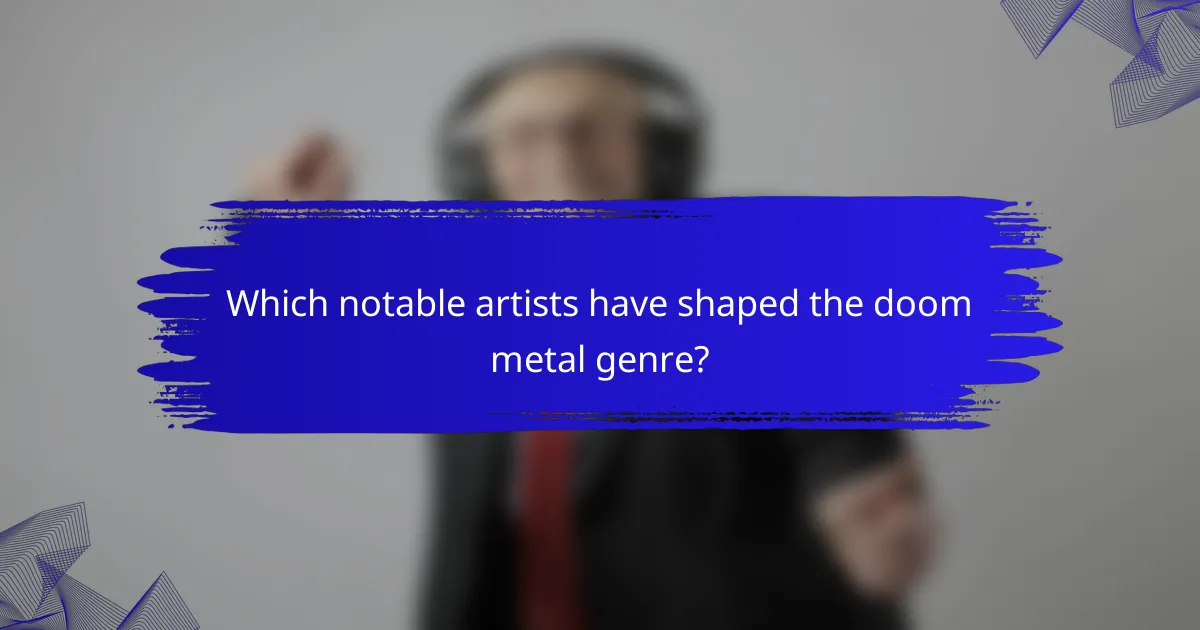
Which notable artists have shaped the doom metal genre?
Several notable artists have significantly shaped the doom metal genre, including Black Sabbath, Candlemass, and My Dying Bride. Black Sabbath, often regarded as the pioneers, introduced heavy riffs and dark themes. Candlemass further developed the genre with epic structures and melancholic melodies. My Dying Bride incorporated gothic elements, enhancing emotional depth. Other influential bands include Pentagram and Electric Wizard, each contributing unique attributes to the genre’s evolution.
What contributions have iconic bands made to doom metal?
Iconic bands have significantly shaped doom metal through their unique sound, atmosphere, and thematic content. Influential artists like Black Sabbath established the genre’s foundational heavy riffs and dark lyrical themes. Candlemass introduced operatic vocals, enhancing the emotional depth of the music. My Dying Bride and Paradise Lost expanded the genre by incorporating gothic elements, adding a unique texture to the sound. These contributions have solidified doom metal’s identity, influencing countless bands and enriching the overall metal landscape.
How do regional variations influence doom metal artists?
Regional variations significantly shape doom metal artists through cultural influences and local sounds. Different regions contribute unique elements to the genre, impacting instrumentation, lyrical themes, and overall atmosphere. For instance, Scandinavian doom often incorporates darker themes and melancholic melodies, while American artists may emphasize heavier riffs and a more aggressive sound.
Geographical factors also influence lyrical content, with artists drawing inspiration from local folklore, history, and landscapes. This results in a diverse range of expressions within doom metal, making it a rich and varied genre. Notable artists like Candlemass from Sweden and Sleep from the U.S. exemplify these regional differences, showcasing how location informs their music’s mood and style.
Moreover, local music scenes can affect the development of doom metal, with certain areas fostering communities that promote collaboration and innovation. This interplay between region and artistry creates a dynamic landscape for doom metal, where each artist contributes to the genre’s evolution while reflecting their unique cultural backgrounds.
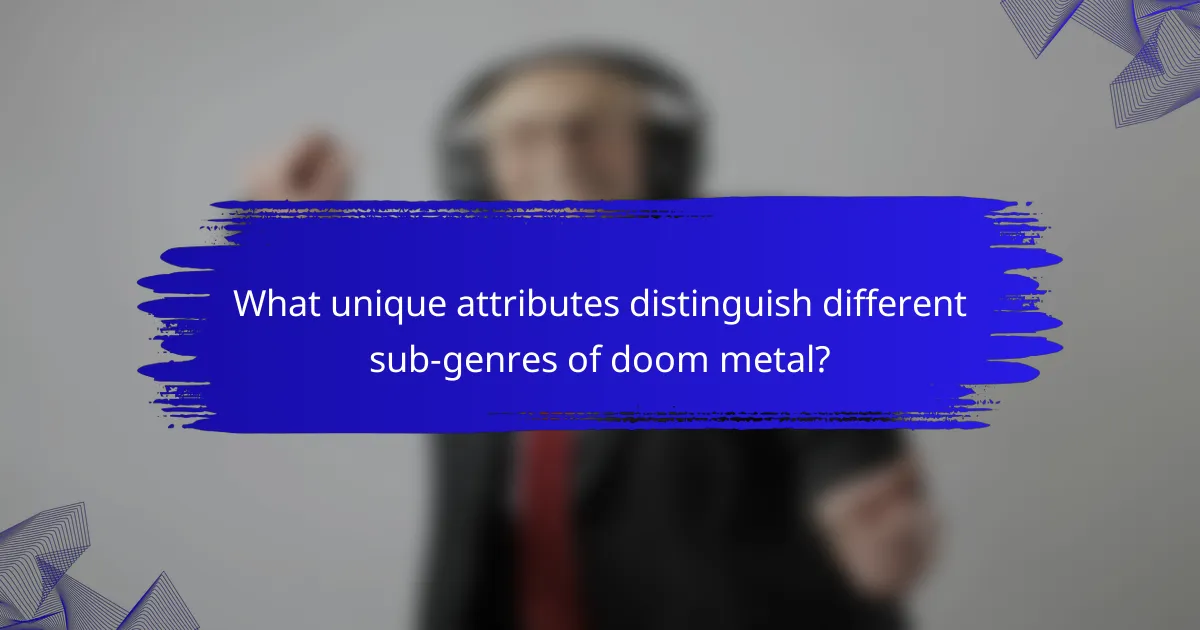
What unique attributes distinguish different sub-genres of doom metal?
Different sub-genres of doom metal are distinguished by unique attributes such as tempo, lyrical themes, and instrumentation. For example, funeral doom features extremely slow tempos and bleak lyrics, while stoner doom incorporates psychedelic elements and a groovier rhythm. Each sub-genre contributes distinct atmospheres, from the oppressive heaviness of sludge doom to the melodic intricacies of death-doom. Notable artists like Electric Wizard and My Dying Bride exemplify these variations, showcasing how unique attributes shape their sound and identity within the broader doom metal landscape.
How does funeral doom differ from traditional doom metal?
Funeral doom differs from traditional doom metal primarily in its tempo, atmosphere, and lyrical themes. Funeral doom features slower tempos, often incorporating orchestral elements and a more melancholic atmosphere. Traditional doom metal maintains a heavier, more straightforward sound with themes of despair and darkness. Notable artists in funeral doom include Evoken and Ahab, while traditional doom is exemplified by bands like Black Sabbath and Pentagram.
What are the characteristics of stoner doom and its cultural significance?
Stoner doom features heavy, slow riffs, a thick atmosphere, and a focus on themes like introspection and existentialism. Its cultural significance lies in its connection to counterculture and the exploration of altered states of consciousness. Notable artists include Sleep, Electric Wizard, and Om, who exemplify the genre’s unique blend of heaviness and psychedelia. The genre’s root attribute is its slow tempo, while its unique attributes include a fusion of stoner rock and doom metal elements, often creating a meditative experience.

Which rare attributes can be found in select doom metal projects?
Rare attributes in select doom metal projects include unconventional instrumentation, unique vocal styles, and experimental song structures. These elements enhance the overall atmosphere and differentiate artists within the genre. For example, some projects incorporate classical music elements or unusual time signatures. Others may feature a blend of ambient soundscapes, creating an immersive listening experience. Notable artists exemplifying these traits include Electric Wizard and Sunn O))).
What experimental approaches have been taken by avant-garde doom artists?
Avant-garde doom artists have employed experimental approaches that blend various genres and unconventional techniques. These artists often manipulate soundscapes, using dissonance and extended song structures to create unique atmospheres.
Notable examples include the use of ambient elements and noise influences, which enhance the emotional depth of their music. Artists like Sunn O))) and Earth incorporate drone techniques, while others experiment with unconventional instruments and recording methods.
This genre’s flexibility allows for a fusion of styles, leading to rare attributes in their compositions, such as the integration of spoken word or field recordings. As a result, avant-garde doom continues to evolve, pushing boundaries and redefining the genre’s sound.
How have collaborations with other genres enriched doom metal?
Collaborations with other genres have significantly enriched doom metal by introducing diverse musical elements. For instance, the infusion of elements from stoner rock has added groove and texture, while progressive influences have enhanced complexity and depth. Notable artists like Candlemass and My Dying Bride have successfully blended orchestral arrangements, creating a more atmospheric sound. Additionally, collaborations with electronic music have introduced innovative production techniques, pushing the boundaries of traditional doom metal. This genre fusion has led to unique soundscapes that captivate a broader audience.
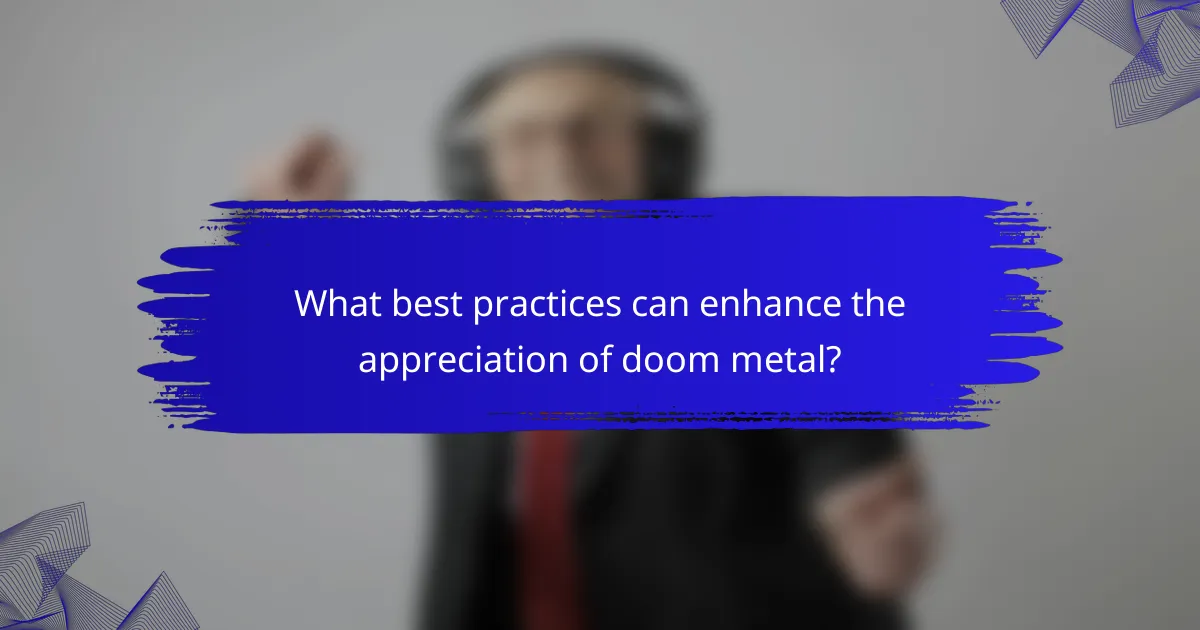
What best practices can enhance the appreciation of doom metal?
To enhance appreciation of doom metal, immerse in its elements, atmosphere, and notable artists. Focus on the genre’s heavy riffs, slow tempos, and melancholic themes. Listening to influential bands like Black Sabbath, Candlemass, and Electric Wizard deepens understanding. Attend live performances to experience the genre’s intense atmosphere. Exploring subgenres, such as funeral doom and stoner doom, reveals its diversity and complexity. Engaging with online communities fosters discussion and sharing of insights, enhancing overall appreciation.
How can listeners deepen their understanding of doom metal’s nuances?
Listeners can deepen their understanding of doom metal by exploring its distinct elements, atmospheric qualities, and notable artists. Engaging with the genre’s slow tempos and heavy riffs creates a profound emotional experience. Notable artists like Black Sabbath and Candlemass exemplify the genre’s signature sound, showcasing lyrical themes of despair and existentialism. Additionally, immersing in live performances allows fans to appreciate the genre’s intensity and communal atmosphere. Understanding the nuances of production techniques used in doom metal recordings can also enhance appreciation for the genre’s depth.
What are common pitfalls to avoid when exploring doom metal?
Common pitfalls to avoid when exploring doom metal include overlooking its diverse subgenres, misinterpreting its lyrical themes, and neglecting the importance of production quality.
Many newcomers focus solely on the slow tempos, missing the intricate guitar work and atmospheric elements that define the genre. Additionally, some listeners may misread the dark themes as purely negative, ignoring the emotional depth and storytelling present in the lyrics.
Another common mistake is underestimating the impact of production techniques. The raw sound often associated with doom metal can obscure the nuances of the music, leading to a superficial understanding of its artistry.
Lastly, failing to explore notable artists and their contributions can limit appreciation for the genre’s evolution and diversity. Engaging with a variety of bands enhances the overall experience and understanding of doom metal.